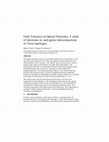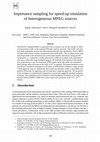Papers by Ragnar Andreassen
ABSTRACT Consider an ATM service, which is charged by the contracted peak rate, but where it is p... more ABSTRACT Consider an ATM service, which is charged by the contracted peak rate, but where it is possible to renegotiate the peak rate against paying a small renegotation charge. Such a service represents a more flexible economic resource sharing than the current practice of fixed capacities. We present an on-line algorithm for renegotiating the peak rate that trades off peak rate charges, renegotiation charges and long-term delay. We compare the performance of the algorithm in terms of charge and delay with the optimal strategy employing full knowledge of the future traffic, and with the constant bit rate strategy. Experiments in a simulation and in an experimental environment with aggregated TCP/IP traffic over an ATM link show that the on-line algorithm considerably reduces the gap between the optimal and the constant bit rate strategy.
IFIP Advances in Information and Communication Technology, 1996
Proceedings of the 7th International Conference on Telecommunications, 2003. ConTEL 2003., 2003
... Evi Zouganeli, Ragnar 0. Andreassen, Rolf. ... At the core nodes, the arbitration is fair in ... more ... Evi Zouganeli, Ragnar 0. Andreassen, Rolf. ... At the core nodes, the arbitration is fair in the sense that it starts serving incoming bursts (of same priority) available at a certain slot period with equal probability and then serves the input fibers in a round robin fashion. ...
Proceedings of the Winter Simulation Conference, 2005., 2005
This paper describes a trace driven, fast simulation approach applicable to deal with the perform... more This paper describes a trace driven, fast simulation approach applicable to deal with the performance evaluation of a multiplex of heterogeneous traffic streams with variable bit rate and long lived serial correlation offered routers in the Internet. A challenge with simulations of the Internet is the huge number of events that are needed for each event of interest, e.g. the loss or excessive delay of a packet. The simulation efficiency of the trace driven approach in this paper is improved by use of importance sampling to provoke constellation of traces where the loss and long delays are more likely. The approach is successfully applied to speedup the simulation of multiplexing of heterogeneous MPEG encoded video streams.
Consider an ATM service, which is charged by the contracted peak rate, but where it is possible t... more Consider an ATM service, which is charged by the contracted peak rate, but where it is possible to renegotiate the peak rate against paying a small renegotation charge. Such a service represents a more flexible economic resource sharing than the current practice of fixed capacities. We present an on-line algorithm for renegotiating the peak rate that trades off peak rate charges, renegotiation charges and long-term delay. We compare the performance of the algorithm in terms of charge and delay with the optimal strategy employing full knowledge of the future traffic, and with the constant bit rate strategy. Experiments in a simulation and in an experimental environment with aggregated TCP/IP traffic over an ATM link show that the on-line algorithm considerably reduces the gap between the optimal and the constant bit rate strategy.

The question considered is how much extra capacity will be required in an optical circuit based c... more The question considered is how much extra capacity will be required in an optical circuit based core network infrastructure compared to an optical packet based core network infrastructure, when producing the same service volume at the same quality. We study this question on the basis of link-level performance gain from the statistical multiplexing of “fluid flow” variable bit-rate traffic streams. We consider effects of source variability, source bit-rates, quality requirements and network sizes. Conclusions are that extra gain from statistical link sharing in packet switched optical links relative to circuit switched optical links is modest when considering common source types currently observed in networks. In smaller core networks, with number of nodes less than 40, the gain observed can be described as insignificant for this type of traffic. Considering future scenarios, the crucial question is whether traffic increases are mainly due to a larger number of sources behaving appro...

The ingress and egress nodes in an all-optical network have an electronic in-and egress part and ... more The ingress and egress nodes in an all-optical network have an electronic in-and egress part and an optical switch. This work analyses various architectures for interconnection of the "electronic" and "optical" parts of the network in order to tolerate single optical switch failures and single optical link failures. The architectures studied are: non-redundant (reference), fault tolerant optical nodes and multihoming of the electronic in-and egress to home node and all neighbouring nodes. The network topology studied is a two-dimensional torus network with symmetric traffic. Network configurations having comparable properties with regard to dependability and traffic transport capacity are compared with respect to link capacity and node switching requirements, i.e. cost. The analysis shows that the fault tolerant networks have nearly the same requirement for link redundancy. The multihomed architecture has less optical switching requirements than even the non-redu...
An optical burst-switched slotted mesh network has been studied by simulation. Focus is on loss p... more An optical burst-switched slotted mesh network has been studied by simulation. Focus is on loss performance for a realistic mix of application sources. Service performance is strongly application dependent. Longer bursts result in lower loss.
Proceedings of the 7th International Conference on Telecommunications, 2003. ConTEL 2003., 2003
ABSTRACT Not Available
DRCN 2005). Proceedings.5th International Workshop on Design of Reliable Communication Networks, 2005., 2005
This paper presents a study of dependability aspects of a switch architecture for optical burst s... more This paper presents a study of dependability aspects of a switch architecture for optical burst switching based on tuneable lasers and array waveguide gratings. For this architecture, we carry out analyses of failure modes, alternative fault tolerance schemes and the relation between redundancy dimensioning and the dependability properties one might expect.
Proceedings of 2005 7th International Conference Transparent Optical Networks, 2005., 2005
Conference onOptical Network Design and Modeling, 2005., 2005
We analyze optical core networks where each node is connected to external electrical client netwo... more We analyze optical core networks where each node is connected to external electrical client networks. We thus consider that nodes have an electronic in- and egress part, serving the client networks, and an all-optical switch that handles the internal traffic. We require of the network that it should be able to tolerate single optical switch failures and single optical link
31st European Conference on Optical Communications (ECOC 2005), 2005
... The authors thankfully acknowledge the contribution of Bargar T Olsen, Te e Jensen, Rima Vent... more ... The authors thankfully acknowledge the contribution of Bargar T Olsen, Te e Jensen, Rima Venturin, Nils Elnegaard, Telenor R&D; 0yvind Arntzen, Telenor Nordic Fixed; Gijs van Oijen, Jean Jennen, Lucent Technologies; Morten Myhrstuen, Loukas Paraschis, Cisco Systems ...

IEE Colloquium on Charging for ATM - The Reality Arrives, 1997
ABSTRACT The authors investigate user aspects of an ATM charging scheme based on measurements of ... more ABSTRACT The authors investigate user aspects of an ATM charging scheme based on measurements of time and volume. Experiments were made on the charging of an ATM-based Internet access connection of a medium sized company division (~250 employees). The object of investigation was to observe whether experimenters equipped with a certain advice of charge interface, and given opportunities to renegotiate choice of tariff during the lifetime of the connection, were able to sensibly adjust to usage incentives of the charging scheme. Three such experiments are reported, each with duration in the range 3-5 days. Experimenter performance was compared to optimal usage strategies by post-analysis of experimental data. A simple heuristic algorithm for automatic adjustment to charging incentives was also investigated. It was found that manually performing tariff renegotiations at the theoretically optimal instants is very difficult. For the tariffs used in the experiments, the ability to hit these instants was however not critical for obtaining quite reasonable charges. Manual operation produced charges 2-13% higher than a minimal charge. The strategies produced by the heuristic algorithm gave charges 0.7-3% over the optimal
…, 2005
... edge of this network and are then for-warded to the destination node according to QoS and tra... more ... edge of this network and are then for-warded to the destination node according to QoS and traffic ... left) and corresponding OCS versus OPS/OBS increase factor κ (right) for the source parameters h = 50 ... We do not assume any over-dimensioning of OCS for protection purposes. ...
Proceedings of 13th …, 2003
Business aspects for a concrete Beyond 3 rd Generation (B3G) mobile system concept referred to as... more Business aspects for a concrete Beyond 3 rd Generation (B3G) mobile system concept referred to as the Open Access Network (OAN) are described. The OAN concept represents a new innovative approach to utilising "private" access lines and equipment; hence no business analysis has been published to date. B3G systems are expected to incorporate many new market players, network concepts and an increasing portfolio of IP-based services. Considering the business opportunities represented by the OAN concept, mutual benefits can be identified for both mobile and fixed network operators as well as new business opportunities for service providers.

The ISO/ITU standard MPEG is expected to be of extensive use for the transfer of video/ moving pi... more The ISO/ITU standard MPEG is expected to be of extensive use for the transfer of video/ moving pictures traffic in the coming ATM high capacity networks. This traffic will stem from both multimedia services like teleconferencing and video distribution. Hence, MPEG encoded video will be a salient constituent of the overall traffic. The encoding causes large and abrupt shifts in the transferred rate at the frame borders and induce strong periodic components, i.e. it generates a traffic pattern that is difficult to handle with a guaranteed QoS and a sufficiently large multiplexing gain. All methods, both analytical and simulation, proposed up to now for evaluation ATM systems under this traffic has substantial shortcomings when cell losses in the order of 10 -9 is required. This paper introduces a new trace driven simulation technique for cell losses in ATM buffers loaded by a large number of heterogeneous sources. Statistically firm results are obtained, within a reasonable computation effort/time, by applying a special importance sampling approach. The properties of the technique is examined and compared to a previously suggested stratified sampling technique. The capabilities of the technique is demonstrated by simulation of 76 sources of nineteen different MPEG VBR video source types with cell losses in the 10 -9 -10 -12 domain.
The current economic climate calls for thoroughly evaluated and economically sound solutions. In ... more The current economic climate calls for thoroughly evaluated and economically sound solutions. In this paper we examine the case for Optical Burst Switching (OBS) based on work that has been carried out within IST STOLAS. The main objective of OBS is to improve the throughput of packet- switched networks. In this paper we present the underlying rationale for OBS networks








Uploads
Papers by Ragnar Andreassen